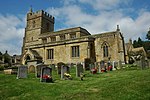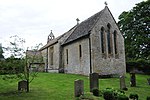Sezincote House

Sezincote House (pronounced seas in coat) is the centre of a country estate in the civil parish of Sezincote, in the county of Gloucestershire, England. The house was designed by Samuel Pepys Cockerell, built in 1805, and is a notable example of Neo-Mughal architecture, a 19th-century reinterpretation of 16th and 17th-century architecture from the Mughal Empire. At the time of its construction, British India was becoming the "jewel in the crown" of the world's largest empire. According to Shashi Tharoor, the palace is an 'incongruous monument to the opulence of the nabobs' loot', referring to the construction of the palace using the wealth acquired by the East India Company's loot and plunder in Bengal.Sezincote is dominated by its red sandstone colour, typical in Mughal architecture, but features a copper-covered dome instead of the typical white marble. The fenestration is composed of a sequence of extra-large windows with an arch-shape at the top. The arch, however, is not a simple or typical design, but instead a shell-like fan that is evidence of the Mughal influence. The interior design is more typical European style. The landscape was designed by Humphry Repton. It is essentially a renaissance-style garden with elements of Hindu style, as seen in the crescent bridge with columns.
Excerpt from the Wikipedia article Sezincote House (License: CC BY-SA 3.0, Authors, Images).Sezincote House
Icehouse Lane, Cotswold District
Geographical coordinates (GPS) Address External links Nearby Places Show on map
Geographical coordinates (GPS)
| Latitude | Longitude |
|---|---|
| N 51.9775 ° | E -1.7512 ° |
Address
Sezincote House
Icehouse Lane
GL56 9AW Cotswold District
England, United Kingdom
Open on Google Maps








